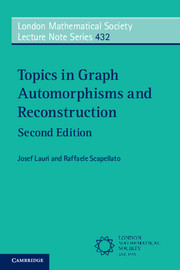Book contents
- Frontmatter
- Dedication
- Contents
- Preface to the Second Edition
- Preface to the First Edition
- 1 Graphs and Groups: Preliminaries
- 2 Various Types of Graph Symmetry
- 3 Cayley Graphs
- 4 Orbital Graphs and Strongly Regular Graphs
- 5 Graphical Regular Representations and Pseudosimilarity
- 6 Products of Graphs
- 7 Special Classes of Vertex-Transitive Graphs and Digraphs
- 8 The Reconstruction Conjectures
- 9 Reconstructing from Subdecks
- 10 Counting Arguments in Vertex-Reconstruction
- 11 Counting Arguments in Edge-Reconstruction
- References
- List of Notations
- Index of Terms and Definitions
Preface to the First Edition
Published online by Cambridge University Press: 05 June 2016
- Frontmatter
- Dedication
- Contents
- Preface to the Second Edition
- Preface to the First Edition
- 1 Graphs and Groups: Preliminaries
- 2 Various Types of Graph Symmetry
- 3 Cayley Graphs
- 4 Orbital Graphs and Strongly Regular Graphs
- 5 Graphical Regular Representations and Pseudosimilarity
- 6 Products of Graphs
- 7 Special Classes of Vertex-Transitive Graphs and Digraphs
- 8 The Reconstruction Conjectures
- 9 Reconstructing from Subdecks
- 10 Counting Arguments in Vertex-Reconstruction
- 11 Counting Arguments in Edge-Reconstruction
- References
- List of Notations
- Index of Terms and Definitions
Summary
This book arose out of lectures given by the first author to Masters students at the University of Malta and by the second author at the Università Cattolica di Brescia.
This book is not intended to be an exhaustive coverage of graph theory. There are many excellent texts that do this, some of which are mentioned in the References. Rather, the intention is to provide the reader with a more in-depth coverage of some particular areas of graph theory. The choice of these areas has been largely governed by the research interests of the authors, and the flavour of the topics covered is predominantly algebraic, with emphasis on symmetry properties of graphs. Thus, standard topics such as the automorphism group of a graph, Frucht's Theorem, Cayley graphs and coset graphs, and orbital graphs are presented early on because they provide the background for most of the work presented in later chapters. Here, more specialised topics are tackled, such as graphical regular representations, pseudosimilarity, graph products, Hamiltonicity of Cayley graphs and special types of vertex-transitive graphs, including a brief treatment of the difficult topic of classifying vertex-transitive graphs. The last four chapters are devoted to the Reconstruction Problem, and even here greater emphasis is given to those results that are of a more algebraic character and involve the symmetry of graphs. A special chapter is devoted to graph products. Such operations are often used to provide new examples from existing ones but are seldom studied for their intrinsic value.
Throughout we have tried to present results and proofs, many of which are not usually found in textbooks but have to be looked for in journal papers. Also, we have tried, where possible, to give a treatment of some of these topics that is different from the standard published material (for example, the chapter on graph products and much of the work on reconstruction).
- Type
- Chapter
- Information
- Topics in Graph Automorphisms and Reconstruction , pp. xiii - xivPublisher: Cambridge University PressPrint publication year: 2016



